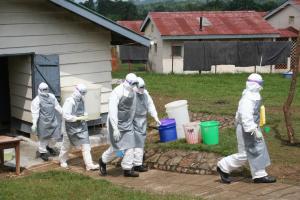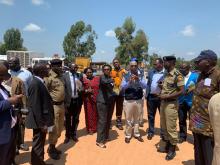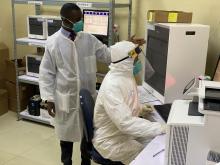How Previous Ebola Virus Disease Outbreaks Helped Uganda Respond to COVID-19 Outbreak
For many public health workers in Uganda, responding to disease outbreaks of epidemic potential in not new. This is because the country has been in preparedness and response modes for quite some time and its disease outbreak system has regularly been tested over the years.
Uganda has had four Ebola Virus Disease (EVD) outbreaks in 2,000, 2014, 2017 and 2018. The biggest and most deadly was in 2000 that registered 425 cases and 224 deaths. In between, the country has also had outbreaks of Marburg, Crimean Congo Hemorrhagic fever, Yellow Fever, Rift Valley Fever, Avian Influenza and measles among others.
These outbreaks have not only tested and strengthened the country’s preparedness and response system but also given health workers enormous experience and steeled their nerves to deal with deadly outbreaks. They have battled these outbreaks close to two decades and managed to stop them.
“Uganda has had the unique opportunity to deal with several disease outbreaks, enabling the country to identify specific factors that contribute to successful management of public health emergencies,” says Dr Jane Ruth Aceng, Uganda’s Health Minister. “Investment from response to these outbreaks has enabled us build strong systems able to prevent, detect and respond to outbreaks. In line with this, we have invested in infrastructure, capacities, institutional relationships and networks”, she adds.
By the time the World Health Organization (WHO) declared COVID-19 a global pandemic on 11th March 2020, Uganda had just contained Ebola in Kasese district on the border with the Democratic Republic of Congo. In fact, the country was still on red alert in anticipation of spillovers from DRC where EVD was still raging.
“Our health workers right from the Village Health Teams across the country to the top management of the Ministry of Health have participated in disease outbreaks and gained a lot of experience in the process. While COVID-19 has its unique challenges such as quick spread, other aspects of dealing with it are pretty much what we have done over the years,” says Dr Henry Mwebesa, the Director-General of Health Services.
Therefore, while COVID-19 is new, in Uganda it found a ready and well-prepared preparedness and response system that just kicked into action when called upon. Certainly, years of investment in human resources, equipment and modest infrastructure came in handy when COVID-19 struck giving the country a reasonably decent response to the outbreak.
Multi-sectoral leadership and Response
To begin with, the country has a multi-sectoral and multi-disciplinary National Task Force (NTF) that is chaired by His Excellency the President of the Country. This gives Uganda, disease outbreak response the political clout that is critical.
Political leadership and commitment have played an enormous role in Uganda’s response to COVID-19 and in earlier disease outbreaks” says Dr Mwebesa. “The chair of the National Taskforce, the President of Uganda, H E Yoweri Kaguta Museveni has demonstrated sound leadership and commitment relaying on science and advice from a scientific advisory committee constituted of renowned Ugandan scientists, while emphasizing a multisectoral approach in the fight against the highly infectious COVID-19” he adds.
“Government of Uganda is employing a holistic approach in responding to the active COVID-19 outbreak. We have a National Task Force that is chaired by HE the President or the Rt. Hon. Prime Minister. The task force has representatives from all key stakeholders in the response and this is a big lesson out of the many outbreaks we have had”, says Dr Aceng. “One of the lessons we learnt from EVD is the importance of cross-border collaboration, a key measure we are following even in the COVID-19 response” she adds.
At the Ministry of Health, the Incident Management System with its response pillars is housed in the Public Health Emergency Operational Center and oversee national implementation of all directives and guidance of the NTF. This is work Dr Mwebesa and his team have done several times. “All our disease outbreak pillars were already operational and are fully engaged in the current COVID-19 outbreak”, he says.
Earlier in April 2019, the Ministry of Health and partners carried a full-scale simulation exercise that enabled the country to identify strengths and gaps in its preparedness and response system. By the time COVID-19 struck, several gaps had been fixed and the new response required only changing of priorities to focus on the new problem but maintain the old and tested strategies and tactics.
The simulation entailed testing functionality of each pillar right from the importation of a case at the country’s Entebbe International airport, through the processes of safe transportation, laboratory testing, contacting tracing, case management, community engagement to safe and dignified burial in case a patient died. Each of these pillars was tested in real-time giving health workers and other frontline workers a real feel of the operations which proved to be a success when the first index COVID 19 case was detected at Entebbe International Airport.
A Robust Surveillance System detects diseases promptly
Prior to the simulation exercise, surveillance for disease outbreak which has now taken on COVID-19 befitted from a robust Integrated Disease Surveillance and Response (IDSR) system that has been undertaking active disease surveillance in communities by Village Health Teams(VHTs), at health facilities by health workers and at border Points of Entry (PoEs) by trained immigration and port health staff.
IDSR as an approach has enhanced the public health surveillance and response to COVID-19, by facilitating early detection of suspects, obtaining laboratory confirmation of the disease, and initiating action at all levels.
“The IDSR system which also includes community disease surveillance has been used and tested over the years. Even in the current COVID-19 response, the system is helping us detect cases in real-time and is one of our most trusted public health tools”, Says Dr Mwebesa. Indeed, the Ministry of Health, WHO and other partners have overtime strengthened the Integrated Disease Surveillance and Response (IDSR) enabling it to detect and respond to any disease outbreak anywhere in the country within 48 hours of notification.
The ISDR system is supported by online application such as GoData, Open Data Toolkit (ODK), mTrack, U-reports and a dashboard which are all meant to make it efficient. These tools facilitate case investigation, contact follow up, visualization of chains on transmission, data exchange as well as supervision, assessment and reporting. There are some challenges with IDSR which as Dr Mwebesa says are being addressed with support from partners. “We hope it will be improved and perfected but for now, IDSR is serving us well in the COVID-19 response, he says.
Patient Management and Health Workers’ Protection
Case management for COVID-19 also found many health workers already knowledgeable and practising infections prevention and control for EVD and other diseases. They are adept at donning and doffing of personal protective equipment and inpatient care skills. “The case management team are managing all confirmed cases and from the discharges recorded, they are doing a good job,” says Dr Mwebesa while explaining the work of the case management team.
Health workers protection is of utmost concern in disease outbreaks and is often an indication of the preparedness of the system. It is noteworthy that as of 22 August 2020, seventy-eight (78) health workers had been infected with COVID-19 and in the same time, health workers have detected, treated and discharged 1,396 confirmed COVID-19 patients with only one (1) health worker death so far.
Uganda also has a network of regional referral hospitals which are the designated treatment centers for COVID-19 patients.
These hospitals have the human and logistical capacity to handle outbreaks and have prepositioned stocks of materials such as PPEs that have been handy in the COVID-19 response.
The decentralized management of COVID-19 cases to a few designated centers at the National and Regional Referral Hospitals has helped maintain essential health services particularly maternal and childhood conditions at district hospitals and lower health centers. The designation of a few selected centers for COVID-19 case management has ensured cost effective use of Personal Protective Equipment (PPE) and other supplies a lesson that was well learnt from the management of EVD.
The Laboratory: Arguably one of a kind in the Sub-region
There is also the Uganda Virus Research Institute (UVRI), a P4 laboratory that serves as the national influenza center, a WHO influenza collaborating laboratory as well as the national diagnostic laboratory for highly infectious viral infections among other capabilities and responsibilities. According to Professor Pontiano Kaleebu, the Director of UVRI, current COVID-19 laboratory work in Uganda is premised on the enormous work done on influenza research that started in 2006 with support from Center for Disease Control, WHO and other partners. Presently, UVRI is mandated to validate COVID-19 diagnosis in the country and has the capacity to test about 3000 samples per day.
The commendable work by UVRI is supplemented by the decentralized testing conducted at Makerere University College of Health Sciences Laboratory, Central Public Health Laboratories, and Mutukula, Elugu and Tororo field laboratories which has reduced the turn round time for samples testing. This decentralized laboratory systems and sample transportation that is supported by WHO also utilized invaluable lesson from the EVD outbreak that required delivery of samples to UVRI within 24 hours of collection in order to address issues of community transmission.
Risk Communication and Community Engagement
COVID-19 Risk communication and community engagement found a team of public health experts well versed in the rapid development of messages and dissemination through already established channels and networks. Indeed, the country was already circulated with COVID-19 messages and information by the time the index case was detected.
“Our field response activities are supported and overseen by District Task Forces which are functional in all our districts. Our community mobilisers are all over the country doing what they have always done” says Dr Mwebese in response to the work going on the communities. “We already had a Risk Communication and Community Engagement Plan for one health, and another one for Ebola Virus Disease, so it was easy to develop one for COVID-19, he adds.
For a vast majority of Ugandans, regular hand washing, social distancing and early seeking of care and complying with them are not entirely new. These measures which are central to the prevention, control and treatment COVID-19, had been drummed down their ears over the years in response to the numerous outbreaks especially EVD.
At district and sub-county levels, mobilization efforts whether public health, political or social are usually led by the Resident District Commissioners (RDCs) who represent the President in every district. The RDCs chair meetings of the District Task Forces (DTFs) and because most of them have a paramilitary background, discipline and strict adherence to rules and guidelines is part of their DNA. This in turn gives the DTFs and lower response structures the efficiency needed in disease outbreak interventions and this has been applied in the current COVID-19 response.
Fortunately for Uganda, there is the highly appreciated grassroots structure – the Village Health Teams (VHTs) composed of mostly young people chosen by their communities to promote health at the community, household, and individual levels. These frontline health workers are the first point of contact between communities and the formal health system. They deliver messages to end users; they counsell affected communities families and individuals; they influence behaviours changes; assist with community engagement; and distribute materials among other responsibilities. Numbering close to 100,000 across the country this carder of dedicated health workers has carried the COVID-19 message widely and deeply in Uganda’s communities.
Logistics and Supplies
During the EVD preparedness and outbreak response, the logistics pillar was responsible for ensuring supplies are made available wherever needed. While the Government was responsible for the overall operational processes, donor partners such as DFID, IrishAID, USAID, working with WHO also assisted with procurement which enable the country build sustainable procurement experience and capacity. UN personnel from UNICEF, WFP, IOM and WHO set up a delivery system that ensured quick delivery of supplies to end line users in real-time which has been a useful experience for COVID-19.
Knowledgeable and supportive journalists
Journalists and other communication specialists also had prior preparation and orientation on reporting about disease outbreaks from various training session organized by MoH and WHO. Many have experience on real-time reporting of EVD and public health issues such that with COVID-19 they only required information on the disease to immediately kick into action.
“The journalist profession depends on trust. You can only be trusted if you report facts. It is better to delay a story than release one with the wrong information” the WHO Country Representative Dr Yonas Tegegn Woldermariam cautioned the journalist in a recent interaction. “Rumours damage reputation and create panic, both locally and internationally making it difficult for us to respond effectively to the outbreaks,” he said. This counsel has been taken seriously by the media in Uganda judging from their support and participation in the current COVID-19 response efforts.
The ever-dependable donors and partners
In Uganda, as indeed in many African countries, no disease outbreak is ever complete without the invaluable contribution of donors and development partners. “We have strong coordination with our development partners who have continued to support us in risk communication, surveillance, case management among response pillar,” says Dr Jane Ruth Aceng, the health minister.
For the COVID-19 response, invaluable contributions channeled through WHO have been from IrishAid EUR 1,830,000; DFID GBP 1,172,778; DANISH DKK 16,565,000; Azerbaijan USD 100,000; GAVI USD 1 million; and JUPSA USD 158,216.92. In addition, Uganda has benefited considerably from donors contributions through the WHO global response fund.
“We appreciate and heartily thank these donors for the invaluable support that has had a tremendous impact not only in the prevention, control and treatment COVID-19 but also on other disease outbreaks in Uganda over the years. Contributions from these donors have saved lives and contributed to sustainable development. We just can’t thank them enough,” says Dr Yonas the WHO Representative.
Earlier in May 2019, the government of Uganda and partners reported an investment of over 18 million dollars in EVD preparedness and readiness. Under this investment, over 10,000 health workers were trained in Infection Prevention and Control (IPC), psychosocial support, surveillance, safe and dignified burial and other aspects of the disease outbreak response.
These trained health workers have reliably and confidently cascaded the COVID-19 IPC measures throughout the country.
In addition, with donor support, several Ebola Treatment Units (ETUs) were constructed across the country and these have in turn been used in the COVID-19 response. Although these centers have not been used to accommodate confirmed COVID-19 patients, they have however been used as quarantine centers for people under observations.
Investment in infrastructure saw the procurement and deployment of ambulances, pickup trucks, motorcycles that have been used to evacuate or transfer COVID-19 patients, for surveillance, and for community engagement activities. In addition, some of the IPC materials for EVD prepositioned at regional referral hospitals, have come in handy for COVID-19 work.
Border entry points and Entebbe International Airport staff were trained in EVD detection and equipped with infrared thermometers and thermo-scanners for the job. In fact, the COVID-19 index case for Uganda was detected by a trained health worker manning the thermal scanner at Entebbe airport.
Of course, there are challenges as Uganda relentlessly battles COVID-19 with the number of infected people increasing every day.
“There are a number of challenges in dealing with this new virus. As you are aware, we are dealing with a rapidly changing virus with minimum information which is equally changing. Logistics availability is a challenge, particularly for testing kits. Since the onset of the outbreak, we have been able to carry out over 250,000 tests. However, if we have more testing kits, we will be able to carry out many more tests and identify potential infections within the communities”, says Dr Aceng.
“Uganda has porous borders with all her neighbours. This complicates screening activities which are primarily setup at the official gazetted points of entry” she adds. To mitigate this challenge, the Ministry of Health is supporting districts to implement community-based surveillance; and is supporting a regional approach to response implementation with cross border surveillance.
Certainly, Uganda has a lot of work to do. Already, 22 COVID-19 deaths have been registered and given the easing of restrictions and social interactions of Ugandans, this portends danger ahead.
“A lot has been done in Uganda, but we need to support the government to even do more within the existing health system. We have to build a sustainable system not only for EVD and COVID-19 but also for other health problems. The more we do on this the better we shall get at it. WHO is there to support the process,” says Dr Yonas.
Health Promotion Advisor
Tel. : +256 414 335505
Cell: +256 772 507906
Email: sensasib [at] who.int
Public Information Officer
Tel. : +256 313 335569
Cell: +256 786 497073
Email: mwebembezie [at] who.int





